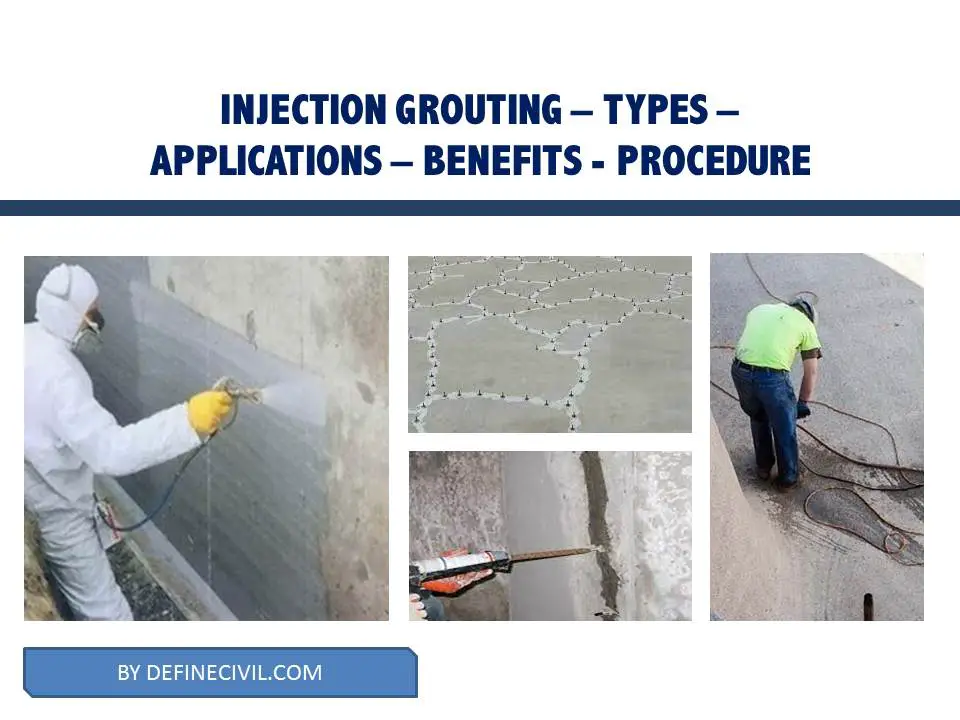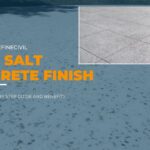Injection grouting is a technique of repair used to fill up gaps, cracks, voids or annular spaces between joints in concrete walls, masonry or underground structures. Injection grouting is carried out with a specialized type of grout material that is filled under pressure and set hardened according to the shape of void or crack.
We use this technique while repairing cracks of damaged masonry structures or making them water proof. We just fill the gaps or voids with a specialized grout material. We can well relate the technique of injection grouting with that of epoxy injection.

What type of grout is used in injection grouting?
Grout can be of many types such as epoxy resin, acrylic resin, cement based grout, high molecular weight methacrylate or polyurethane resin. These provide structural strength and additionally used to cure water leakage in non-accessible spaces.
For the grouting to be workable, we need to make sure the grout is of non-shrinkable material. Sometimes we add additives or chemicals that are fillers or expansive agents. This is a critical parameter of grout to make structural stable and crack free for number of years down the road.

Selection of grout material
Grout material is densely flow able and does not crack or crumble after setting. For better results, the grouting material should have to be compatible with the original material in terms of setting and binding.
Purpose:
The fundamental purpose of injection grouting is:
- To fill the cracks and voids for consolidation
- We use injection grouting to prevent water leakage, water plugging and sealing joints
- To prevent corrosion of internal construction material
- To narrow down the chance of surface subsidence
- Strength and reinforcing the existing structures.
Applications:
Injection grouting has very wide range of application areas such as in dams, in irregular shaped stone masonries, cracks and gaps in concrete surfaces, in lining the tunnels, in strengthening the foundations and underground pipeline work etc.
Types of injection grouting:
Cement sand grouting:
It is one of the widely used method for concrete based repair using cement as a grouting material. A portable mixture of cement and sand with high water content is injected at high pressure into the voids and cracks and this hardens up to set in the spaces.
Cement sand grouting fills the gaps and improves the strength of rock formation in underground that may provide additional preconstruction site benefits.
The best thing about cement sand injection grouting is that it is very easy to use. The materials are readily available in the market has good results in terms of strength enhancement.
However, without any additive, the cement sand grout will shrink upon hardening resulting in cracking of grout.
Fiber reinforced injection grouting:
This type of grouting has again applications in concrete and masonry work structural members. It makes use of different fibers like steel, glass or polypropylene etc. mixed in fixed ratio with cement or mortar. It has much strong hardening properties and improves ductile strength and resistance to impact and ductility. Fiber reinforced injection grouting demands skilled handling to avoid disintegration of fibers. If you’re looking to increase flexural strength of a structure, fiber-reinforced grout is the best.
Polymer based injection grouting:
As the name suggests, this grouting is done with polymers like vinyl ester, polyester, epoxy, resins and polyurethane. The most widely employed polymer is epoxy resin due to its strong binding and sealing properties. Epoxy resin is suitable for almost every type of cracks may it be surfaced or underground. For water associated structures like pipes, acrylic resin and polyurethane is suggested to block water seepage as they have good water impermeability and chemical resistance. They come in mixture of two or three components based on varying properties. The consistency or desired property of polymers is adjusted by adding curing agents and modifiers. Generally epoxy based, acrylic based and lignosulfonate based polymer injection grouting is available
Gas forming grouts:
Gas forming grouting is done using some key ingredients like carbon powder and aluminum which react with the water and portable cement to generate gas bubbles. The gas bubble forms then swell and thicken the grout to fill the voids and compensate the shrinkage. This grouting requires additional handling and application protocols as the bubbles are temperature sensitive. Cracks that are exposed to temperature extremities require suitable handling for gas forming grouts in order to achieve maximum strength and desired volume. Quick application is the key as the reaction occurs too fast.
Sulfo-Aluminating grout:
This grout is made up of sulfo-aluminate additive or shrinkage compensating cement and heavily relies on shrinkage compensation principle. The additive is mixed with Portland cement and water which results in expansion of the additive. As this grout are sensitive to hydration, so proper moist curing and post hardening procedures are required.
Procedure:
- Drilling surface holes or ports
Small venting terminals are made by drilling holes or ports into the cracks or gaps to be used as entry points. The depth and spacing between the drills is adjusted as desired. The cracks appeared during drilling are sealed using epoxy or acrylic resin
- Cleaning the drill holes and cracks
Clean the drills by flushing water through them to wet the internal surface for efficient grout flow and binding and to know about pattern of voids continuation.
- Grouting hose connections
Hose connection are made in grouting using cone shaped grout hose with maximum pressure. Short nipples or gasket devices may also be used for this purpose.
- Injection grouting in the cracks
Start grouting from one vertical or horizontal end until the grout bulges out from the next drill. Plug the bulged drill and move to next and repeat.
Specifications:
The mixture shall be pour-able and viscous type. Grout pumps shall be helical screw type with long stroke. The air supply has not to be less than 200 cubic feet per plant. Pressure gauges to be installed at hole as well as at pump. All the drills and hose must be compatible with pressure specified.
Advantages of Injection Grouting
- Injection grouting is very easy to do as materials are readily available.
- The grout and the grouting process are economical.
- It is a very environmental-friendly process with no harshness to the environment.
- You can easily use injection grouting to repair cracks or fill voids in all structural members including concrete and masonry members.
- It can give your structural elements stability and strength, especially to masonry structural members.
- The wastage is minimum when you follow the correct procedure of injection grouting.



















